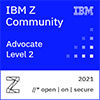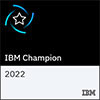The Arcati Mainframe Yearbook 2023 is now available for download from https://itech-ed.com/arcati/ – and it’s FREE. Each new Yearbook is always greeted with enthusiasm by mainframers everywhere because it is such a unique source of information. And each year, many people find the results of the user survey especially interesting.
This year, the results came from the 100 respondents who completed the survey between the 21 October 2022 and the 25 November 2022. Just over half (55 percent) were from North America. 15 percent were from the Asia/Pacific region, and another 15 percent of respondents were from Europe. 10 percent were from South America. And five percent were from the Middle East/Africa. The largest group of respondents were from companies with over 10,000 employees worldwide (31 percent). Just over a fifth (21 percent) had 200 to 1000 employees. And 16 percent of respondents were each from companies with under 200 staff, between a thousand and five thousand, and, lastly, between 5000 and 10,000 employees worldwide.
It was an interesting survey this year, seeing how various sites are adopting the new technologies – although Java has been around for 25 years – and how the world of the mainframe seems to be integrating with cloud computing in a hybrid environment. Clearly, working with mainframes is an interesting way to spend your day – particularly as they are able to reach out to the cloud, mobile devices, and Internet of Things (IoT) devices, and the way DevOps practices can speed up what was a very slow process of application development. CICS, IMS, and Db2 continue to have quarterly updates that add value to the products.
In terms of what’s new (or, perhaps more correctly, what appears on a lot of PowerPoint slides), the survey found that 56 percent of sites are already using Splunk or equivalent. And a further 12 percent said that they were planning to use it. The survey also found that 67 percent of sites were already using DevOps (up from 44 percent last year), with a further 13 percent planning to use it. And 62 percent of all respondents (up from 53 percent last year) said that they were already reusing APIs to speed up application development, with a further 19 percent of sites planning to reuse APIs. Blockchain has been in the news a lot, but doesn’t seem to be close to mainstream, yet. Seven percent of sites reported already using it (last year no-one did), and only seven percent are planning to use it. With Docker, we found that 20 percent of respondents were already using it (up from 17 percent last year) with 47 percent at the planning stage.
Zowe, the open-source way of accessing mainframes, was introduced in 2018. 38 percent of sites said that they are already using it (double last year’s figure of 19 percent), with a massive 31 percent of sites having plans to make use of it in the coming year. Open-source technology is now becoming commonplace on mainframes.
When it comes to Web-enabling subsystems, we found that 80 percent of organizations were Web-enabling CICS. 65 percent of sites are Web-enabling Db2. 45 percent of sites are Web-enabling IMS. 50 percent are Web-enabling WebSphere Application Server. We also found that 39 percent of sites already use Liberty (well up from 8 percent last year), with 15 percent planning to install it.
Mainframes in an organization are just one of the computing platforms people use (along with phones, tablets, laptops, Power systems, etc), and, for a long time, there has been an issue, at many sites, with mainframes being accepted in the enterprise. The reason suggested by 85 percent of sites was that the biggest obstacle was the difficulty in retaining the necessary skills. And this, perhaps, highlights the need for a product like Zowe. 55 percent of sites thought that the biggest obstacles to mainframe acceptance within the enterprise was that it’s too expensive (or appears to be). The figure was 90 percent last year. 50 percent thought the biggest obstacle was a cultural barrier between mainframe and other IT professionals (up from 40 percent last year). 30 percent felt concerns about future availability/support of mainframe apps was an obstacle. 25 percent of respondents thought that a barrier was the mainframe being too complex (or appearing to be too complex). And 10 percent of respondents didn’t think that there were any barriers to mainframe acceptance. Let’s hope that last figure rises in the future.
Reinforcing the value of the mainframe to organizations, the survey found that 94 percent of sites have seen some kind of increase in capacity, and 93 percent have seen an increase in technology costs, but only 77 percent of sites believe their people costs have increased! Interestingly, 67 percent of sites say that the bulk of their IT budget is spent on cloud, leaving 33 percent of sites where the majority of their expenditure is on the mainframe. We’ll track how those values change over the next few years.
But no organization is going to develop an asset unless they view it as having a future, and we all know the mindset that still exists about the mainframe, treating it as little more than your dad’s technology. Unfortunately, the survey found that 53 percent of sites viewed their mainframe as a legacy system. Worryingly, only 10 percent (down from last year’s figure of 17 percent) still viewed mainframes as strategic. 37 percent viewed mainframes as strategic and legacy!
When asked what, in their opinion, are the main benefits to their organization of the mainframe over other platforms, 85 percent of respondents highlighted the benefit of availability. 70 percent of respondents highlighted security. This figure is down from the 100 percent response last year, and yet breaches and ransomware still should be a major concern. 65 percent of respondents identified scalability, with 50 percent highlighting manageability as benefits.
This year’s survey found that the z15 is the most popular model (at 50 percent of sites). The newer z15 Model T02 was found at a quarter of the sites, as was the z14 Model ZR1. The older models (z13s, z13, z12BC, z12 EC, and z114) are still out there and still performing well. It must be noted, when looking at these statistics, that many sites had more than one model of mainframe installed. We were, unfortunately, unable to collect information for z16 usage. In terms of operating system, 40 percent of respondents were using z/OS Version 2.5 (a huge increase on last year’s figure of just seven percent). Another 40 percent of sites are using Version 2.4 (last year it was 57 percent). Lastly, 20 percent were using z/OS Version 2.3.
Looking at hybrid cloud computing, the survey found that 42 percent of respondents currently used their mainframe in a hybrid cloud environment (up from 21 percent last year). A further 16 percent think that they will run a hybrid cloud environment at some time in the future, with 11 percent planning to run a hybrid cloud environment soon. A further 42 percent don’t use hybrid cloud and don’t have any plans to do so. We asked whether respondents use Red Hat OpenShift and/or IBM Cloud Paks on their mainframe. Only 12 percent of sites said yes, with nearly a quarter suggesting that they have plans to do so. We also asked which cloud providers mainframe sites used. Amazon Web Services (AWS) was the most popular at 35 percent, followed by Azure at 25 percent.
Linux is often in the news, so it was interesting to see what our respondents had to say about it. There are considerable cost and management benefits from consolidating distributed Linux workloads onto the mainframe. However, 61 percent of respondents weren’t interested in LinuxONE mainframes. Six percent of sites said they already had one, with 22 percent expecting to get one at some time in the future, and 11 percent expecting to get one in the next year. No sites in the survey said their primary operating system was Linux. Having said that, around a third (31 percent) of respondents said that they run Linux on IBM Z.
Security breaches and ransomware are becoming a major issue – with the average breach costing $4.35 million. Perhaps worryingly, 21 percent of respondents said that they weren’t worried about ransomware. No-one said they had a solution in place, although 79 percent were worried or very worried about it. So, still good news for criminal gangs and rogue nation state hackers.
Mainframes continue to offer a cost-effective, secure, and powerful platform for organizations with the necessary background and expertise in place to support it. It seems that non-mainframe IT staff and managers are not getting the opportunities to find out about the multitude of advantages that using a mainframe can bring to an organization – in terms of security, reliability, availability, flexibility, as well as understanding the true total cost of ownership figures for the platform. Perhaps Zowe will continue to help the mainframe to appear like any other server to a younger generation of programmers and managers.


